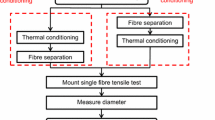Abstract
The reinforcement of glasses by incorporation of fibres was considered to depend on the force transfer from the matrix on the fibres in order to obtain optimum strength and fracture toughness. This may occur by thermal shrinking of the matrix on the fibres after the hot-pressing procedure. It is shown that an optimum exists for strain and stress transfer from the matrix to the fibres if this shrinkage process is neither so strong that no pull-out and no bend-over effect is produced nor so weak that no stress transfer is possible. Therefore, experiments were performed with Nicalon-SiC fibres and with selected glasses which show different thermal expansion coefficients. In this way it was possible to produce fibre-reinforced glass composites with well-tailored special properties. Estimations of tensile stresses within the glass matrix led to values which are partly above those of the bulk glass. Because no cracks occurred during cooling and during heat shock treatment fromT g, it was concluded that the strength of the thin glass layers between the very smooth surfaces of the Nicalon-SiC fibres cannot be compared with that of bulk glass but with that of protected (coated) glass fibres or thin sheet glass.
Similar content being viewed by others
References
J. Aveston, G. A. Cooper andA. Kelly, The properties of fibre composites: single and multiple fracture” Paper 2 Conference Proceedings (National Physical Laboratory Teddington, UK 1971) pp. 15–26.
J. Aveston andA. Kelly,J. Mater. Sci. 8 (1973) 352.
R. A. J. Sambell, D. H. Bowen andD. C. Phillips,ibid. 7 (1972) 663.
D. H. Bowen, D. C. Phillips, R. A. J. Sambell andA. Briggs,Soc. Mater. Sci. Jpn 5 (1972) 123.
H. Poritsky,Phys. 5 (1934) 406.
A. W. Hull andE. E. Burger,ibid. 5 (1934) 384.
H. Stockhorst, Dissertation, TU Berlin (1984).
H. Hegeler andR. Bruckner,J. Mater. Sci. 24 (1989) 1191.
G. Simon andA. R. Bunsell,ibid. 19 (1984) 3658.
T. J. Clark, R. M. Arons, J. M. Stamatoff andJ. Rabe,Ceram. Engng Sci. Proc. 65 (1985) 576.
K. M. Prewo,J. Mater. Sci. 21 (1986) 3590.
R. Warren andC.-H. Anderson,Composites 15 (1984) 101.
S. Yajima, J. Hayashi andM. Omori,Chem. Lett. 9 (1975) 931.
E. Fitzer andR. Gadow,Amer. Ceram. Soc. Bull. 65 (1986) 326.
A. Petzold, Anorganisch-Nichtmetallische Werkstoffe, VEB Deutscher Verlag für Grundstoff industrie, Leipzig 1981, pp. 66–7.
G. D. Redston andJ. E. Stanworth, The British Thomson-Houston Co. Ltd, Research Laboratory, Rugby (1945).
Schott Technische Gläser, Firmeninformation (1981).
Feldmühle, Keramik Werkstoffdaten, Firmeninformation (1986).
G. W. Scherer, “Relaxation in glass and composites” (Wiley, New York, 1986).
G. Gratwohl, B. Meier andD. Spelman, Institut für Keram. im Maschinenbau, Universität Karlsruhe Jahresbericht (1987) pp. 1–44.
R. L. Stewart, K. Chyung, andM. P. Taylor,Fract. Mech. Ceram. 7 (1986) 33.
B. Bender, D. Shadwell, C. Bulik, L. Incorvati andD. Lewis III,Amer. Ceram. Soc. Bull. 65 (1986) 363.
D. B. Marshal,J. Amer. Ceram. Soc. 67 (1984) C259.
M. K. Brun andR. N. Singh,Adv. Ceram. Mater. 3 (1988) 506.
Author information
Authors and Affiliations
Rights and permissions
About this article
Cite this article
Hegeler, H., Brückner, R. Fibre-reinforced glasses: influence of thermal expansion of the glass matrix on strength and fracture toughness of the composites. J Mater Sci 25, 4836–4846 (1990). https://doi.org/10.1007/BF01129950
Received:
Accepted:
Issue Date:
DOI: https://doi.org/10.1007/BF01129950




